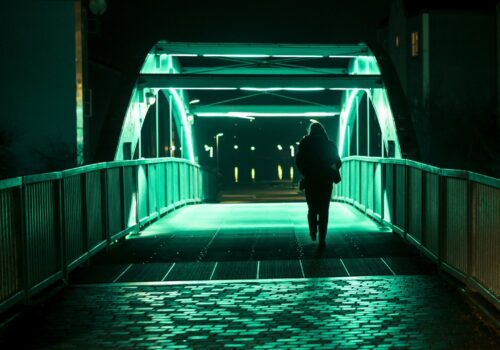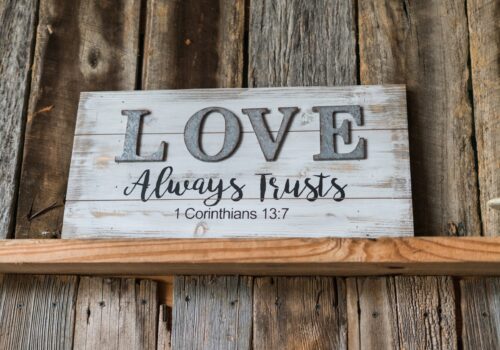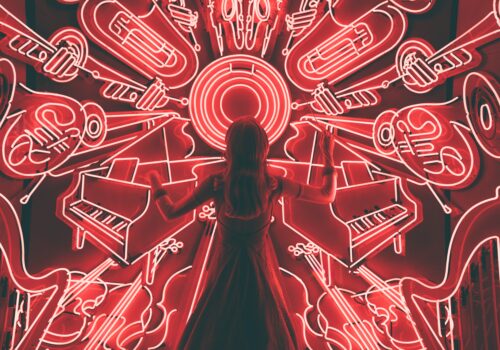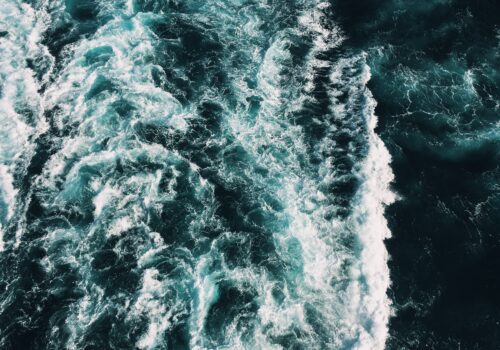Download PDF: Schedneck, Complicated Identities
It’s an amazing country. The guy who bakes your bread there is Iranian, the person running the restaurant is Indian, and the carpenter’s Punjabi. The man who irons your clothes is from Madras, the taxi driver’s Pathan, the electrician’s Pakistani, the salesperson’s Indian and the nurse who gives you an injection is from Ceylon. We’re like ornamental fish or birds: they feed us, clean out our pools and cages, and like looking at us. In this country we’re just something to look at.
Muhhamed Murr, Dubai Author
“We’ve been talking a lot about individual identity this semester,” Professor Elizabeth Greason said to her Introduction to Literature class at the American University in Dubai (AUD). “Now I want to talk about identity of a place. Can a city have its own identity?”

Dubai is one of the seven different emirates making up the United Arab Emirates, and the most populous city in the U.A.E. The majority of the population of Dubai is made up of expatriates, including individuals from India, Pakistan, Bangladesh and Iran. While Islam is the state religion, there are also large communities of Christians, Hindus, Sikhs and other religious groups
Several students nodded at Professor Greason’s question while others appeared unsure. From the back row, I counted eight local male students, an inordinately high number for a single class at AUD. Like the rest of Dubai, this private institution has an extremely diverse student population of over eighty nationalities, with local Emirati students in the minority. Professor Greason, a friend and colleague, had invited me to observe her students’ discussion on national identity. As a young, American professor new to Dubai, I was curious to learn what local students had to say about the decline of their religious and cultural traditions within this rapidly modernizing city.
The class took place in November of 2007, a few days before the country’s 36th National Day celebration. In his National Day speech, Sheikh Khalifa, the president of the United Arab Emirates (UAE), declared 2008 the year of National Identity. “One who has no identity has no present, and will have no future,” he said, emphasizing the need for locals to remain true to their culture’s past and take part in defining its future, rather than becoming subsumed into the 80% expatriate population and losing their tribal, Islamic heritage. He declared that anyone without a strong sense of identity would be “destined to remain in obscurity.” And if there was one thing Sheikh Khalifa and Sheikh Mohamed, the Vice President of the UAE and ruler of Dubai, feared, it was falling off the map once again, receding back into the sands, to a time when no one had heard of this tiny country in the Gulf.
Sheikh Khalifa’s weighty rhetoric made the celebration of that year’s National Day sound like more than just another reason to commemorate the country’s independence and achievements, but instead like the beginning of a serious and potentially contentious debate. Central to this debate is deciding which aspects of Dubai’s past to carry over and how those qualities might be fused with modern Dubai lifestyle to create a new, dynamic and inclusive sense of belonging and pride in the UAE. At the time I joined Professor Greason’s class, the verdict on which aspects of modern life to allow and which traditions to preserve was still very much in question. I wanted to know how the local students felt about their identity on this upcoming National Day. Was their situation as dire as their ruler’s words suggested? Did they lack an understanding of their present and future?
Professor Greason began the discussion. “I think places, particularly cities, do have their own identities. What about Dubai? How would you characterize its identity?”
Students from all directions of the classroom called out, “the Burj al Arab,” “luxury,” “crowds, traffic,” “development,” “multicultural.” Then a local student called out, “tradition,” and his friend said, “evolving.”
Professor Greason was writing their descriptions on the board. “Good,” she said, “I like those last two especially. Do you think the Emirati tradition is evolving?” The students nodded, but were reticent to explain how.
On a recent trip into downtown Dubai, I had stopped in the Four Seasons Ramesh Gallery. I picked up a half dozen reproduced photos of old Dubai and put them on my refrigerator at home: photos of camels grazing in the desert alongside a local man carrying buckets of water on a wide yoke; photos of Emirati boys dressed in white robes, sitting on the sand, holding the canes now used in performances of traditional dances. Another picture showed the lined face of a Bedouin man who had spent his life in the desert sun, a falcon perched on his wrist. The last was a photo of half a dozen dhows floating along Dubai Creek, with one man in a tiny boat shuffling between them. These grainy photos showed the time before the discovery of oil beneath those sands, before the city evolved into the words and phrases the students had called out to describe their city. They showed the UAE’s past and Emirati traditions.
The country’s history consists of centuries of tribal life, where nomadic Bedouin and settled people subsisted in the harsh desert by fishing, cultivating dates and diving for pearls in the Arabian Gulf. The tribes lived without schools, hospitals or roads until oil exploration began in the 1950s and tribal leaders started using their new wealth in the 1960s and 70s. In 1971, the British relinquished their nearly 180 year protectorate relationship with the region, and the seven separate sheikhdoms along the Gulf Coast, known as the Trucial States, united to form one country, the United Arab Emirates. Since its inception, the concept of national identity has been actively discussed and pursued. In the past, such discussions necessarily focused on bringing together the disparate tribes of the seven sheikhdoms under one federation and one leader. Now that national, rather than tribal, allegiance has been firmly established, the task of UAE citizens has become defining Emirati identity among and against the foreign majority, particularly the western cultural influx.
Sheikh Rashid bin Saeed Al Maktoum, Dubai’s ruler from 1979 to 1990, created the infrastructure to turn Dubai into a financial center for the Middle East and Africa, as well as a tourist hub. Beginning in 2006, Sheikh Mohamed has taken up his father’s agenda with even more enthusiasm, bringing in half a million South Asian laborers to construct business and residence towers, and establishing free trade zones for international companies. The expatriate population has steadily increased, now outnumbering the local citizens by six to one. Hotels abound, with housing, bars and nightclubs for expatriates. Such a transient city has left Dubai ripe for exploitation and social problems. While all of the projects to increase foreign business and tourism have created significant wealth for the country and the local population, the speed of the changes has caused citizens to question the preservation and definition of their values and identity amid all of these Western influences and accommodations.
“Miss, I do not agree that the Emirates are just evolving. It is more than that. We are losing our identity in Dubai.”
“Go on, Nasser,” Professor Greason said.
“Our people are changing too much,” he said. “For example, during Ramadan this year, it wasn’t the non Muslims eating in public that made me mad, but the locals who didn’t keep their religion, who didn’t fast. The exposure to other cultures makes them think they don’t have to follow the religion or culture.”
A South African student responded, “You can’t blame us for your sins.”
“I agree,” another local student said. “I don’t think we should make excuses for ourselves, but it’s really hard because there are so few locals in comparison to expats. Weakness makes you go along with the majority, and most are weak.”
“Ok, that’s a very honest answer, Yusuf,” Professor Greason said.
Nasser spoke up again, “At AUD, there were more short skirts during Ramadan — a challenge for us! We have to go to university with our eyes covered.” He put his hand over his eyes, feeling around him with his free hand as if figuring out how to leave his seat without looking at any woman. The class laughed at his antics.
“As a South African, I was offended by Ramadan here because of all the lavish eating options during iftars.” She spoke of the meal when Muslims break their fast at sundown. “It’s not kept as holy as it is where I’m from.”
“Christmas is respected more here,” another local student said. “I’m tired of all the decorated trees and holiday songs. It’s nice for westerners, but what about us?”
“I agree with you, Abdullah,” Professor Greason said. “So what is Emirati culture? Can we define it?”
Yusuf spoke up. “There is a difference between Emirati culture and all Muslim culture, Miss. You can say Emirati and mean strong follower of Islam, but really that’s just a part, a section.”
“It used to be that malls closed during prayer time,” the local at the front of the room said. “In Saudi Arabia, there are no classes during prayer time; all students go together to the mosque. Here, we can’t even hear the call.”
“Our culture comes from the desert,” Abdullah said, “but we never spend time there anymore.”
This last comment in particular reminded me that Emirati tradition is made up of so many things. Islam and the religious culture surrounding it are prominent, but the tribal codes of honor and hospitality that arose from a life in the desert have to be included alongside the country’s rise to oil wealth and financial fame. By listening to the local students’ eclectic responses, I saw how difficult it might be to bring all of these pieces together into a coherent whole.
“Sheikh Zayed is the UAE and the UAE is Sheikh Zayed,” Nasser said, referring to the country’s founder and first leader. A revered figure throughout the country, his strong gaze from billboards photos throughout the city is unmistakable. “When the father leaves any family, the family changes.”
“So many bad things have happened since Sheikh Zayed died,” the local student sitting next to me added. “He used to give any local whatever he wanted, but this doesn’t happen anymore. Sheikh Zayed would have stopped all the social problems we are now facing.”
“The leader can never go on with a country,” Yusuf said. “He leaves it for others to continue.”
Nasser said, “Dubai will have to change no matter what we do. It’s the new America because we are losing our own culture and all becoming the same. It’s hard to hold onto our culture.”
“So who does Dubai want to be?” Professor Greason asked.
Nasser said, “We need to share the good, Islam, encourage that, but we don’t. Instead we take what ‘they’ give us without thinking about its value to our culture. There should be more of an equal exchange. There should be more effort to get across Emirati culture.”
Professor Greason said, “There’s a responsibility to share your culture. What can you do to ensure this?”
“It’s about ourselves,” another local at the front of the room said. “We can show others our culture through our language and the way we dress, through our openness. Just like you cannot force me to wear a shirt here, I cannot force you to wear a kandora in the UAE.”
The South African woman said, “There should be free Arabic courses for expats, like the would-be American citizens have to learn English and American history to become citizens.”
The local man next to me snickered and said under his breath, “We barely use Arabic anymore.”
Professor Greason said, “That’s a good point. Identity is infused in language. Islam, references to God in inshallah and mashallahare in almost every sentence you use in the language. When the language disappears, so do the cultural references.”
I spoke up and said that the government had just made Arabic the official government language, but the boys involved in the debate weren’t impressed.
“It shouldn’t have to be that way,” Yusuf said. “It shouldn’t have to be made official. That just shows we are losing local language and it’s a big problem. I know locals who can’t even read the Koran. Lose Arabic and you lose your religion.”
“So is Emirati the culture of Dubai anymore?” Professor Greason asked.
“It’s all business now. The government only thinks like a company without worrying about social issues,” Abdullah said.
Professor Greason said, “Can’t great business development happen alongside thriving Emirati culture?”
“But Miss, this isn’t us, others are causing this success, not us, and we have to change because of it,” Yusuf said.
Professor Greason said, “Why did you guys choose an American university then?”
Most local students chose to attend the national universities for free. Those who opted for AUD were showing their preference for a more liberal educational environment, among other reasons.
Nasser said, “You get a better education here. You can’t find work if you go to a university taught in Arabic.”
A covered girl in the front of the room said, “With an American degree, you can be accepted anywhere for a job.”
“This school has no identity, it’s all individual, an American education in Dubai,” the local next to me said. “But we have to adapt to the changes, that’s why we’re here.”
“Do you guys ever talk about this?” Professor Greason asked.
“Sometimes we do, but nothing will change,” Yusuf said.
“Guys, you’re so pessimistic. I think this is a historic moment!” Professor Greason said. “To me, you all symbolize Dubai in this classroom”with all your nationalities and cultures engaging in this debate. And you guys, Nasser and Abdullah and Yusuf, you are Emirati culture to me, that mix of tradition and modern, with your kandoras and baseball caps.”
They smiled, adjusting their Ed Hardy caps. I liked the way Professor Greason tried to infuse her concluding comments with hope. Yet they looked at her askance, another western teacher sweeping in and out of their lives.
As Professor Greason and I walked back to our offices, we commented on how personally the young men took the discussion. Their conservative views surprised me. With more western values, they could have some of the freedoms I thought all young men wanted, like meeting girls in one of the several large malls or movie theaters. Yet from that classroom discussion, at least, such freedoms seemed like something else the local students must strive to avoid.
More than that, they only seemed to see the negative side of modernization. I thought they would praise all the many positive developments brought on since oil discovery, such as modern healthcare and free education. Even the existence of this university would have been beyond the expectations of their parents’ generation. These young people grew up during the modern era and only had their parents and grandparents to impart their memories of communal villages of the past. Today, an average of two foreign servants work for each national family, which has spurred the common joke that local children speak better Malayalam, Tagalog and Tamil than they do Arabic. Perhaps these young people were so accustomed to living among modern amenities that they couldn’t appreciate all they had been given, and only felt a sense of loss.
Over the next few days, I asked a few of my local students their thoughts on being a minority in their own hometown. Shamma wondered why alcohol had to be served in this country at all, saying, “expats would still come here if there were no bars and clubs.” He commented on how frequent yet incongruous it was to find a bar across the street from a mosque. Another student, Hinaya, explained to me, “The more you’re exposed to things you shouldn’t be exposed to, the more you want to grab onto your religion and your identity. I have access to everything I’m not allowed to and it’s hard to resist what’s right in front of your face.” When two of my male students echoed these ideas, I realized that many of the locals at AUD simply wanted a middle ground. If Dubai is a place of extremes, then these young men and women felt pulled in two very different directions.
At the National Identity Conference of 2008, the various speakers all agreed that this debate particularly affected young Emiratis. Khalfan Musabih, cultural adviser at the Sheikh Mohammad Bin Rashid Foundation, said, “National identity is to feel you belong to your homeland and to feel zeal toward everything related to it.” Dr. Ameenah Al Daheri, a professor at UAE University said that national identity “includes culture, heritage, traditions and loyalty to the UAE.” Yet such abstract statements would not help my students navigate their modern lives and Islamic cultural traditions. Only through such conversations and debates in classrooms like Professor Greason’s could awareness, and change, begin to take place.
While these kinds of dialogues may be difficult to undertake in over-taxed college classrooms, this is a topic that weighs heavily on the minds of most students in multi-cultural Dubai. Local students should know that they are not alone in feeling overwhelmed by western values, and expatriate students of all backgrounds should try to to understand the issues their Emirati peers face. All of these students need teachers who are willing to take on the national identity debate, who can lead discussions with compassion and critical awareness, all the while modeling a sense of optimism and presenting concrete ways to achieve real understanding between locals and expatriates. The safe zone of a classroom where all opinions are listened to and valued is particularly conducive to tackling such a complex issue.
At a Federal National Council public debate on National Identity, Wejdan Al Mutairi, a local student of Zayed University, said: “For nine months we have been hearing about the national identity. Nobody has told us what the national identity is.” Instead of waiting, Emirati students have opportunities within the open, tolerant classrooms of the American University in Dubai to come up with ways to describe their identity for themselves.
Feature Photo by Christopher Sardegna.






